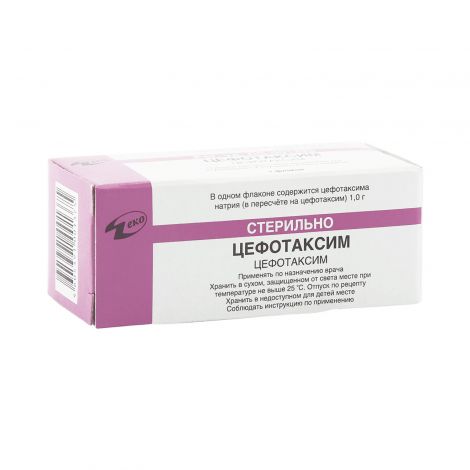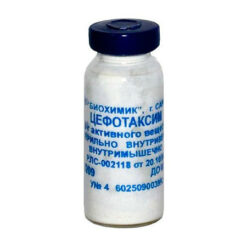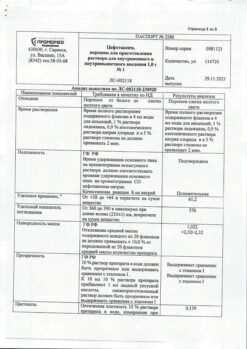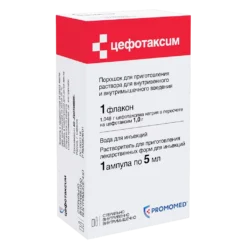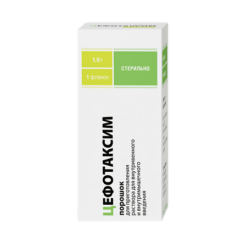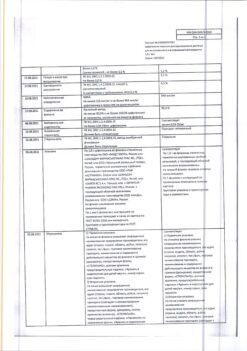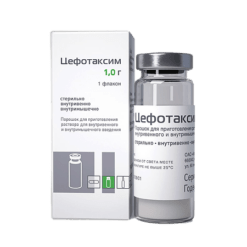No products in the cart.
Cefotaxime, 1 g
€1.04 €0.95
Out of stock
(E-mail when Stock is available)
Description
Third-generation cephalosporin antibiotic for parenteral administration. It acts bactericidally. The mechanism of action is associated with disruption of mucopeptide synthesis of the cell wall of microorganisms. It has a wide range of antimicrobial action.
The drug is active against Gram-positive and Gram-negative microorganisms resistant to other antibiotics: Staphylococcus spp. Staphylococcus aureus, including penicillinase-producing strains, except for strains resistant to methicillin), Staphylococcus epidermidis (except for strains resistant to methicillin), Streptococcus pneumoniae, Streptococcus pyogenes (group A beta-haemolytic streptococci), Streptococcus agalactiae (group B streptococci), Enterococcus spp.Enterobacter spp. , Escherichia coli, Haemophilus influenzae (including penicillinase-producing strains), Haemophilus parainfluenzae, Moraxella catarrhalis, Klebsiella spp. (including Klebsiella pneumoniae, Klebsiella oxytoca), Morganella morganii, Neisseria gonorrhoeae (including penicillinase-producing strains), Acinetobacter spp, Corynebacterium diphtheriae, Erysipelothrix rhusiopathiae, Eubacter spp., Propionibacterium spp., Clostridium spp. (including Clostridium perfringens), Citrobacter spp., Proteus mirabilis, Proteus vulgaris, Providencia spp. (including Providencia rettgeri), Serratia spp, some strains of Pseudomonas aeruginosa, Neisseria meningitidis, Bacteroides spp. (including some strains of Bacteroides fragilis), Fusobacterium spp. (including Fusobacterium nucleatum), Peptococcus spp.
Inconstant effect on some strains of Pseudomonas aeruginosa, Acinetobacter spp., Helicobacter pylori, Bacteroides fragilis, Clostridium difficile.
Resistant to most beta-lactamases of Gram-positive and Gram-negative microorganisms.
Indications
Indications
Infectious and inflammatory diseases caused by susceptible microorganisms, including:
– CNS infections (meningitis);
– respiratory and ENT organ infections;
– urinary tract infections;
– bone and joint infections;
– skin and soft tissue infections;
– pelvic organ infections;
– abdominal infections;
– peritonitis;
– sepsis;
– endocarditis;
– gonorrhea;
– infected wounds and burns;
– salmonellosis;
– Lyme disease;
– immunodeficiency infections.
Prophylaxis of infections after surgical operations (including urological, obstetric and gynecological, gastrointestinal organs).
Active ingredient
Active ingredient
Composition
Composition
Interaction
Interaction
Cefotaxime increases the risk of bleeding when combined with antiaggregants, NSAIDs.
The risk of renal damage increases with concomitant use of aminoglycosides, polymyxin B and “loop” diuretics.
Drugs that block tubular secretion increase plasma concentrations of cefotaxime and slow its excretion.
Pharmaceutical interactions
Pharmaceutically incompatible with solutions of other antibiotics in the same syringe or dropper.
Directions for use
Directions for use
The drug is administered intravenously (by stream or drop) and intravenously.
The drug is indicated in adults and children over 12 years of age (with body weight â¥50 kg)
In uncomplicated infections, as well as in urinary tract infections, 1 g every 8-12 hours by IV or IV.
In uncomplicated acute gonorrhea – in a dose of 1 g once in/m.
In cases of moderate infections, it is administered in/m or intravenously in a dose of 1 to 2 g every 12 hours.
In case of severe infections, e.g. meningitis – intravenous 2 g every 4-8 hours, maximum daily dose – 12 g. The duration of treatment is determined individually.
In order to prevent development of infections before surgical operation it is administered once in a dose of 1 g during introductory anesthesia. If necessary the administration is repeated in 6-12 hours.
In case of caesarean section – at the moment of application of umbilical vein clamps – intravenously in dose of 1 g, then in 6 and 12 hours after the first dose – 1 g additionally.
In case of CK â¤20 ml/min/1.73 m2 the daily dose is reduced by half.
In premature and newborns under 1 week of age – i.v. in dose 50 mg/kg every 12 hours; at 1-4 weeks of age – i.v. in dose 50 mg/kg every 8 hours. In children with body weight â¤50 kg – intravenously or intramuscularly (children over 2.5 years of age) 50-180 mg/kg in 4-6 doses.
In case of severe infections (including meningitis) the daily dose when administered to children is increased to 100-200 mg/kg, i/m or i/v in 4-6 injections, the maximum daily dose is 12 g.
Regulations for preparation of injection solutions
For IV injection: 1 g of the drug is diluted in 4 ml of sterile water for injection; the drug is administered slowly over 3-5 minutes.
Special Instructions
Special Instructions
Patients with a history of allergic reactions to penicillins may have hypersensitivity to cephalosporin antibiotics.
In treatment with the drug for more than 10 days peripheral blood counts should be monitored.
False positive Coombs test and false positive urine glucose reaction are possible during treatment with cefotaxime.
Contraindications
Contraindications
– pregnancy;
– children under 2.5 years of age (for intravenous administration);
– hypersensitivity (including to penicillins, other cephalosporins, carbapenems).
The drug should be used with caution in infants, during lactation (in small concentrations excreted with breast milk), in chronic renal failure, with UCI (including in anamnesis).
Side effects
Side effects
CNS disorders: headache, dizziness.
Urinary system disorders: renal dysfunction, oliguria, interstitial nephritis.
Digestive system disorders: nausea, vomiting, diarrhea or constipation, flatulence, abdominal pain, dysbacteriosis, liver function disorders; rarely – stomatitis, glossitis, pseudomembranous enterocolitis, increased liver transaminases and alkaline phosphate activity, hyperbilirubinemia.
Hematopoietic disorders: hemolytic anemia, leukopenia, neutropenia, granulocytopenia, thrombocytopenia, agranulocytosis, hypocoagulation.
Cardiovascular system disorders: potentially life-threatening arrhythmias after rapid bolus injection into the central vein.
Laboratory parameters: azotemia, increased blood urea concentration, hypercreatininemia, positive Coombs reaction.
Local reactions: phlebitis, soreness along the vein, soreness and infiltration at the site of injection.
Allergic reactions: urticaria, chills or fever, rash, skin itching; rarely – bronchospasm, eosinophilia, erythema malignant exudative (Stevens-Johnson syndrome), toxic epidermal necrolysis (Lyell syndrome), angioedema, anaphylactic shock.
Others: superinfection (vaginal and oral candidiasis).
Overdose
Overdose
Symptoms: convulsions, encephalopathy (in case of administration in high doses, especially in patients with renal failure), tremor, neuromuscular excitability.
Treatment: symptomatic, no specific antidote.
Pregnancy use
Pregnancy use
Similarities
Similarities
Additional information
| Weight | 0.020 kg |
|---|---|
| Shelf life | 2 years. |
| Conditions of storage | List B. The drug should be kept out of reach of children, in a dry place protected from light at a temperature not exceeding 25 ° C. |
| Manufacturer | Deco Company, Russia |
| Medication form | Powder for preparation of solution |
| Brand | Deco Company |
Other forms…
Related products
Buy Cefotaxime, 1 g with delivery to USA, UK, Europe and over 120 other countries.

